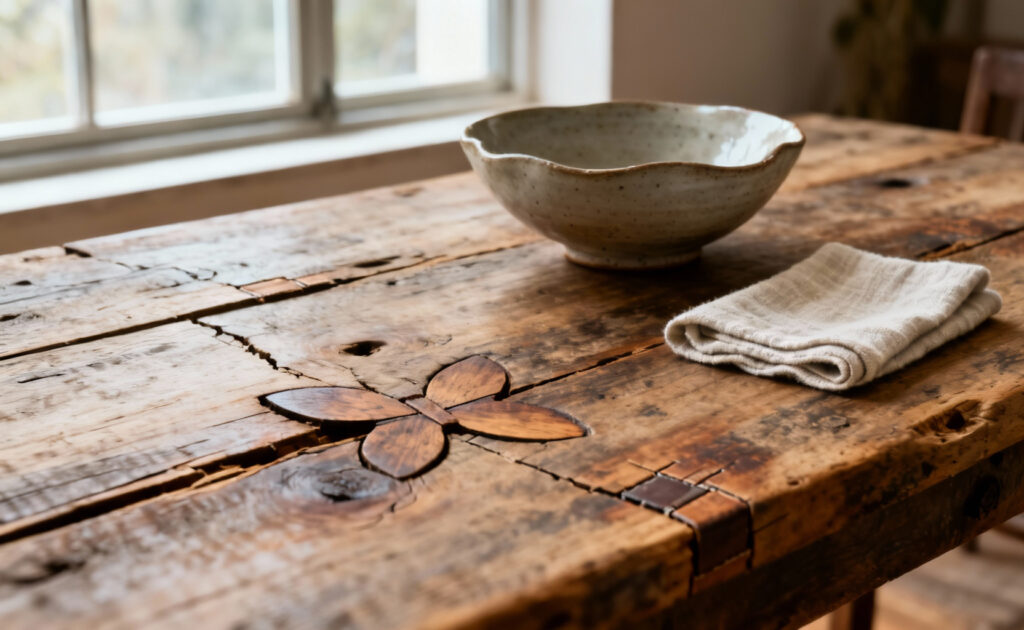For centuries, the dining room in a working home was more than a place to eat; it was the heart of the household, a sanctuary for gathering. It has evolved from its utilitarian origins in agrarian farmhouses to its modern role as a sophisticated statement of natural elegance. Today, the most compelling spaces understand this dual identity—they must earn their visual presence while serving the deep, human need for connection. What separates a truly enduring rustic dining experience from a fleeting trend are a set of principles that, frankly, haven’t changed much at all.
As a specialist in historical architecture, my work is about honoring that legacy. It’s about recognizing that genuine authenticity comes not from mimicking a style, but from a profound respect for materials, craftsmanship, and the story a home has to tell. The superficial version of rustic is easy to spot—it’s a collection of signs and factory-distressed furniture. The real thing, however, possesses a quiet, abiding soul.
This is a guide to finding that soul. We will move from the foundational philosophy of what makes a space feel truly rustic, to the specific materials that form its canvas. From there, we’ll discuss how to arrange these elements in space and light, and finally, how to integrate this design into a way of life. This isn’t about creating a showroom; it’s about crafting a testament to enduring craftsmanship, a place for cherished traditions.
Reclaiming Heritage: The Enduring Ethos of Rustic Dining Design
The soul of a rustic dining room is found not in its objects, but in its philosophy. It begins with a deep connection to history, craftsmanship, and the unvarnished truth of the natural world. This is our foundation.
1. Embracing Wabi-Sabi: The Beauty of Imperfection
The very heart of authentic rustic design is a philosophy I’ve come to see as its most critical, yet misunderstood, element: an appreciation for the imperfect. The Japanese call it Wabi-Sabi—a worldview centered on accepting transience and finding beauty in the flaws that mark the passage of time. This means actively rejecting the sterile uniformity of mass production in favor of materials that tell a story. Think of timber with its knots and grain, hand-forged iron still bearing hammer marks, or pottery with the subtle variations of the artisan’s hand.
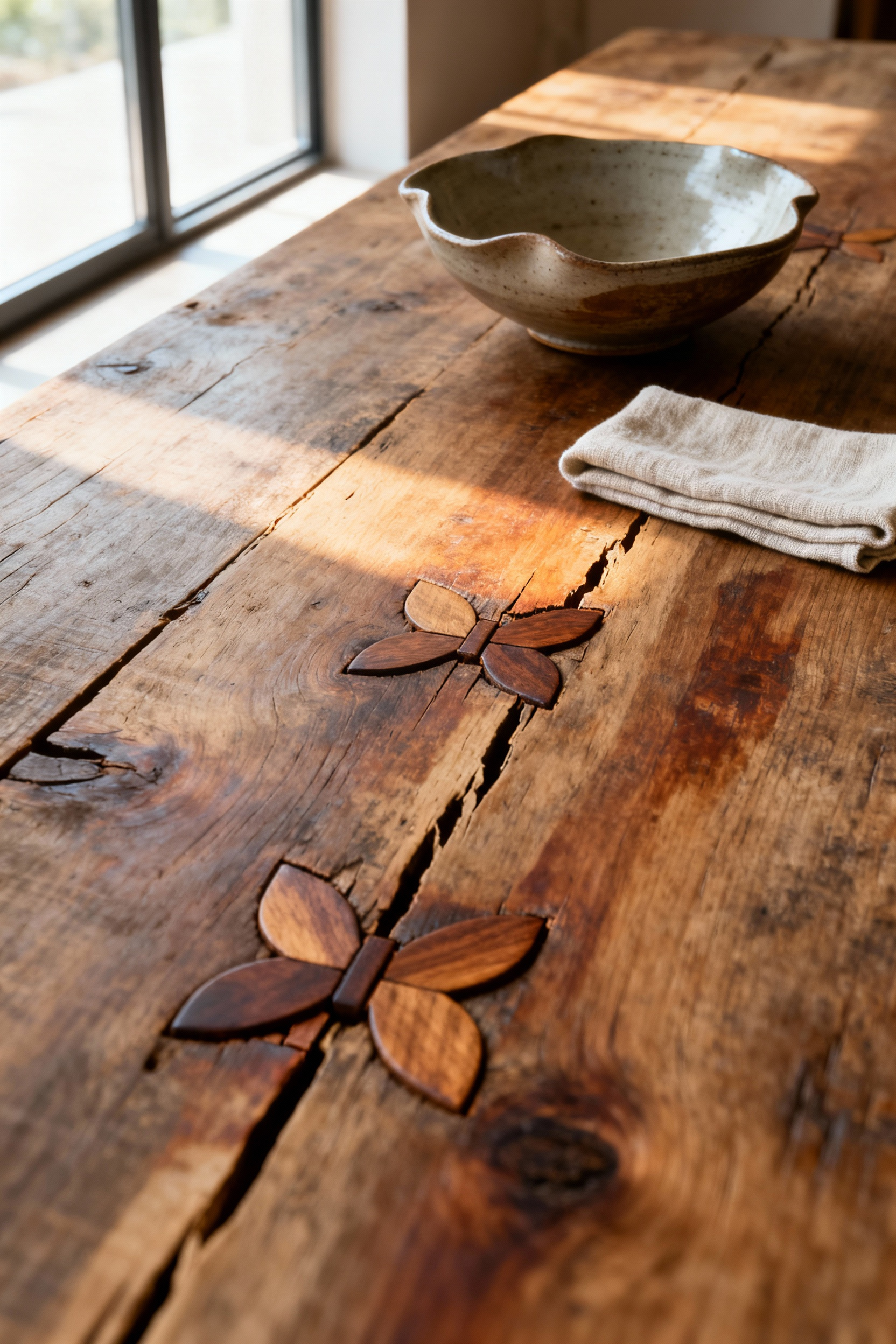
What I often explain to my clients is that we are not looking for damage, but for character. A slightly warped tabletop isn’t a defect; it’s a testament to the life of the wood. This approach allows us to create compositions that feel assembled over time, not staged in a single afternoon. It might be mismatched antique chairs unified by a common wood tone, or a table bearing the marks of countless family meals. The goal is to cultivate a space that feels approachable, honest, and deeply comforting—a room that doesn’t demand perfection from its inhabitants.
2. Harnessing Provenance: The Story in Salvaged Elements
Once you embrace imperfection, you can begin to truly appreciate the power of salvaged architectural elements. Provenance—the history and origin of an object—is what gives a rustic dining room its narrative depth. Reclaimed timber beams, barn wood planks, or aged stone flooring aren’t just building materials; they are artifacts, each groove and blemish a testament to a former life. In my historical renovation practice, I’ve seen that integrating these pieces is an act of preservation, a way of weaving history directly into the home’s new chapter.
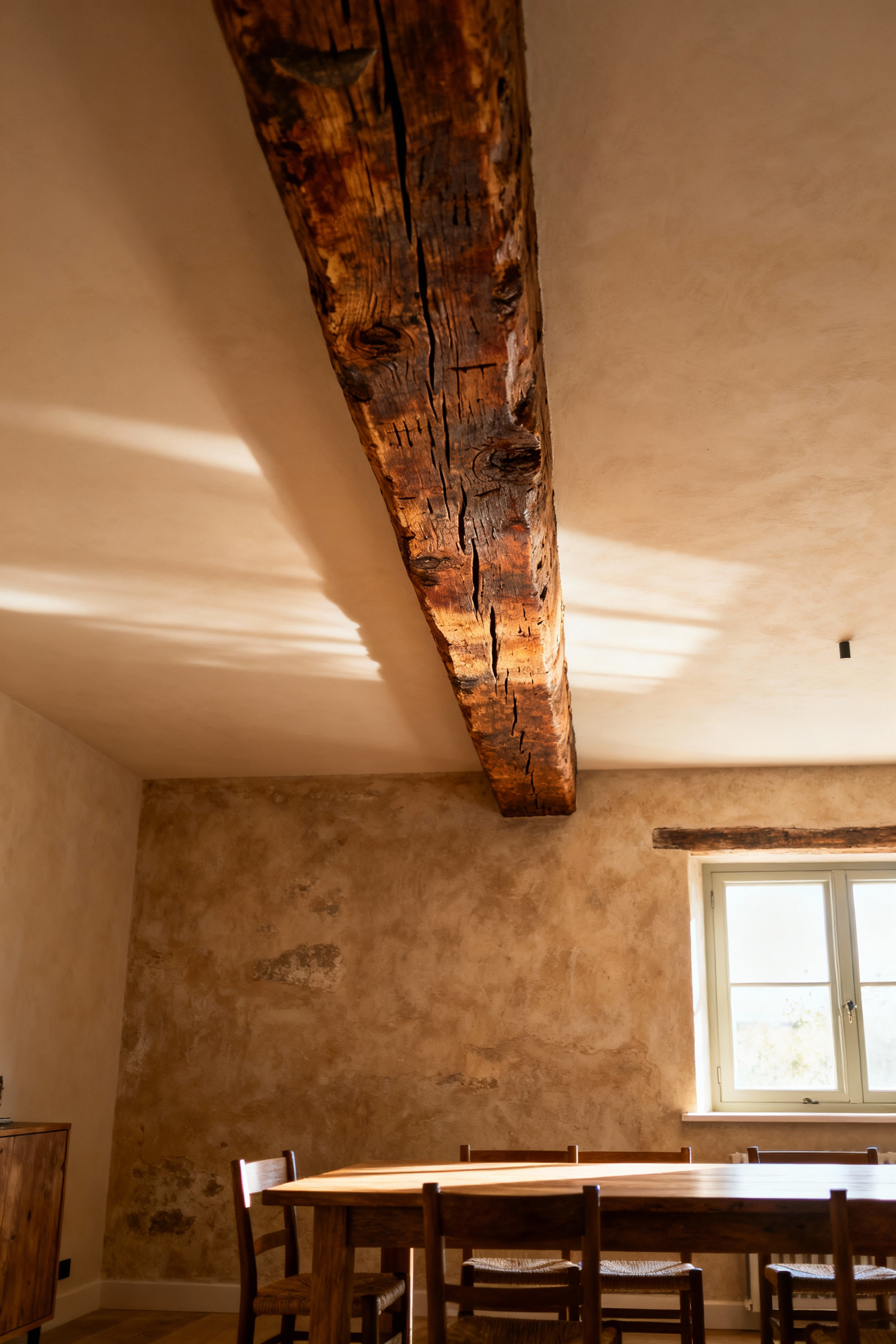
Consider a dining table crafted from centuries-old heart pine joists. Its surface tells a story that no new piece of lumber ever could. Spatially, these elements are transformative. Exposed reclaimed beams can define the architectural skeleton of a room, bringing immediate warmth and scale. A wall clad in reclaimed wood grounds the space in natural texture. By choosing salvaged materials, you’re not just making an aesthetic choice; you’re being a steward of resources and creating an environment that feels profoundly rooted and alive with the echoes of the past.
3. Articulating Agrarian Aesthetics: The Dialogue Between Form and Function
The inherent value we find in salvaged elements comes from the honest design wisdom of their original purpose. This leads us directly to the core principles of agrarian aesthetics, where the dialogue between form and function is everything. Born from necessity, agrarian design is inherently utilitarian, free of any ornamentation that doesn’t serve a purpose. It champions robust materials capable of withstanding the rigors of daily life.
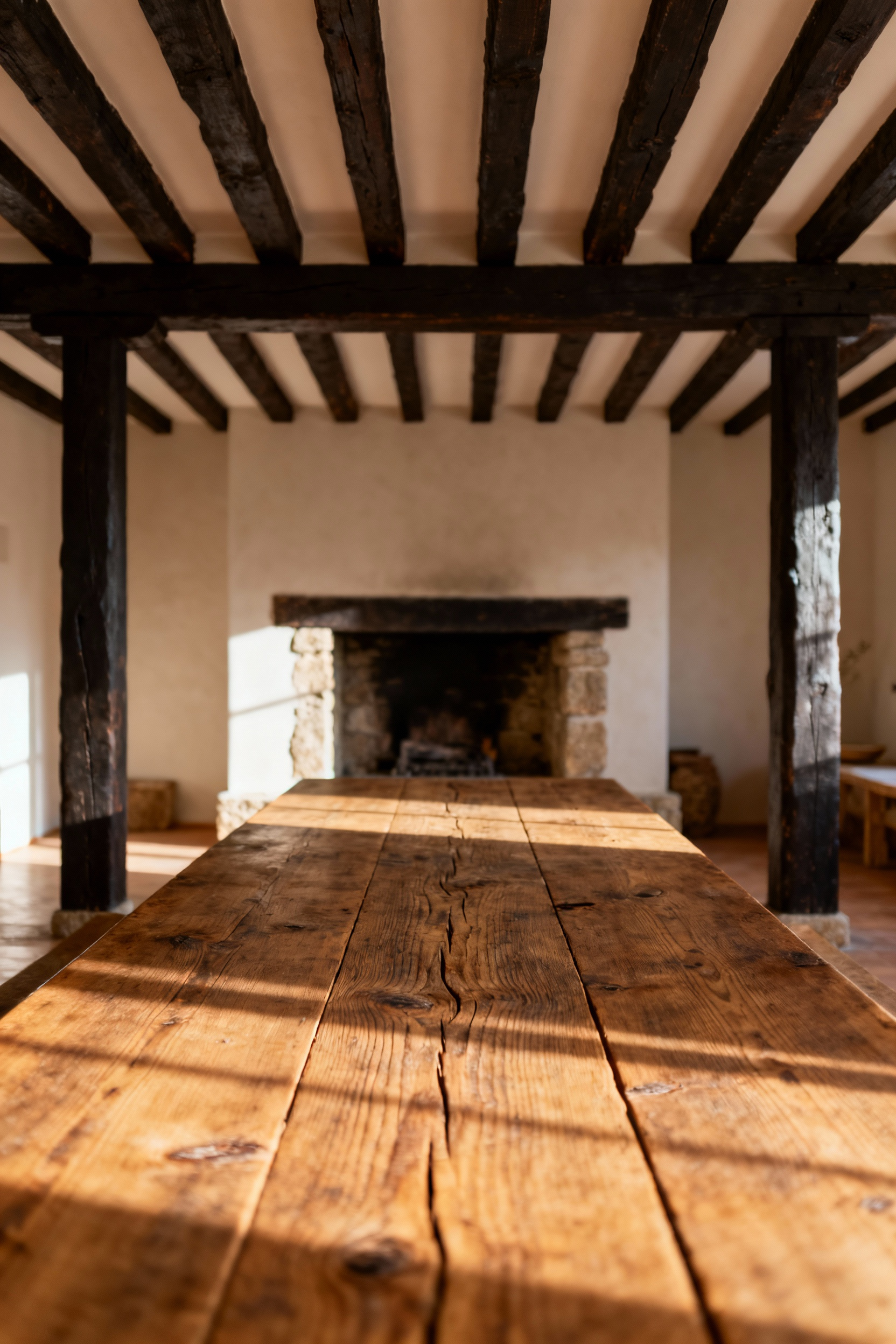
This is where the material exploration becomes focused on honesty: solid woods like oak or pine, durable iron, and simple woven textiles. Finishes are minimal, allowing the material’s true nature to be the focus. For your rustic dining room, this means choosing furniture where the construction is visible and true—sturdy mortise-and-tenon joinery, hand-turned legs, and thick tabletops built for generations of use. This commitment to functional beauty results in a space that is not only handsome but supremely livable, embodying a pragmatic elegance where every single element has earned its place.
4. Curating Patina: Valuing the Accumulation of Time
An environment built on honest function is the perfect canvas for the development of patina—the soft sheen and subtle discoloration produced by age, wear, and care. Patina is the visual record of time and use, an inimitable signature that elevates an object from a simple item to a cherished part of a home’s story. This isn’t something you can buy; it’s something you cultivate with patience.
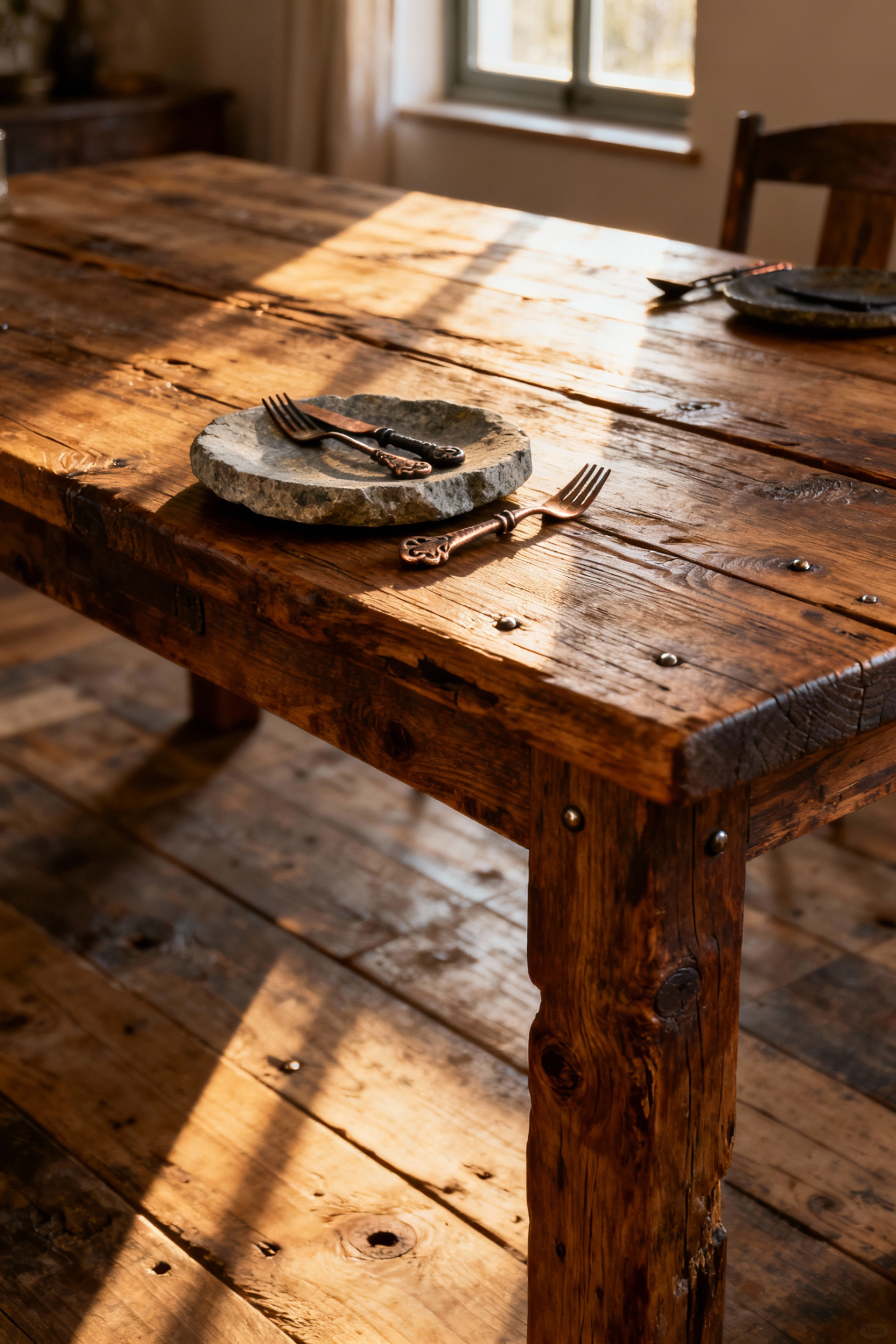
The beauty of patina is most evident on natural surfaces: the deepening luster of seasoned wood, the gentle oxidization on copper or brass, the soft fading of natural linens. These are not flaws to be polished away but revered signs of life. Years of working on period-appropriate renovations taught me that homeowners are often tempted to “restore” a finish too aggressively, erasing the very history they fell in love with. Instead, I advise them to choose finishes that will age well and to embrace the marks of a life well-lived. A rustic dining room should gain character over the years, becoming more inviting and authentic with every meal shared.
5. Anchoring in Indigenous Craftsmanship and Local Materials
The soul of a truly authentic rustic dining room comes from its connection to place. This philosophy champions a respect for the wisdom embedded in indigenous craftsmanship and a commitment to using local materials. True beauty emerges from the honest expression of elements shaped by skilled, local hands, connecting your space to its specific geographical and cultural story. It’s a clear rejection of placeless, industrial homogeneity.
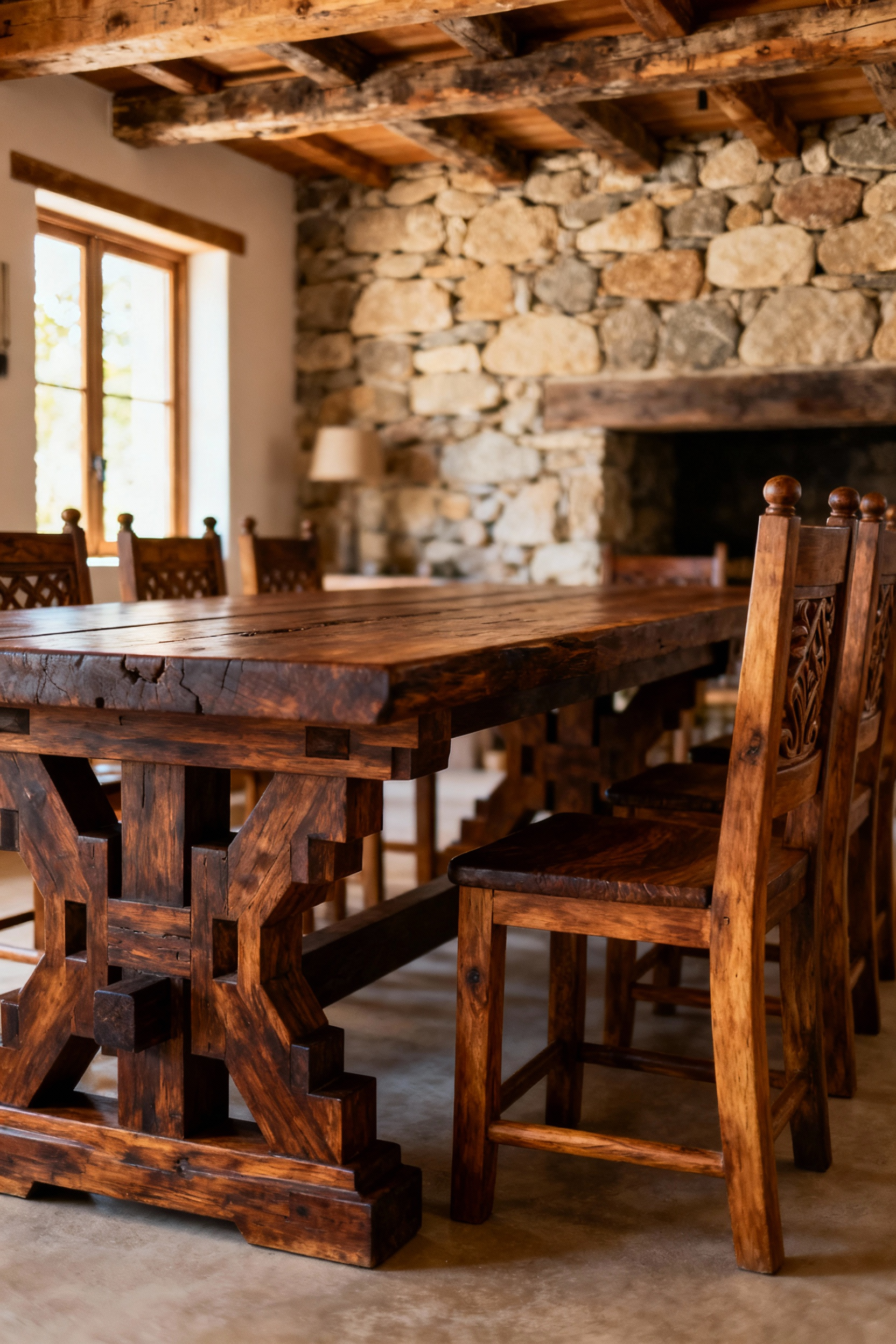
This means engaging with materials not just for how they look, but for what they are and where they’re from. Reclaimed timbers from a local barn, granite quarried nearby, or ironwork forged by a neighborhood smith all carry a narrative that cannot be imported. Imagine a monumental dining table, its surface bearing the subtle undulations of hand-planed local oak. Every piece is selected for its authentic character and its ability to age gracefully, acquiring more beauty with time and use. This thoughtful approach ensures the design remains timeless, untouched by passing fads, and stands as a true heirloom.
Elemental Authenticity: Crafting the Canvas with Natural Materials
Once the philosophy is set, the focus turns to the physical. An enduring rustic design is built upon the authenticity of its foundational elements—the wood, stone, metal, and fiber that create the room’s tactile reality.
6. Integrating Hewn Timber Beams and Hand-Scraped Flooring
The most powerful rustic rooms begin with a profound respect for their structural components, allowing them to declare their inherent beauty. Instead of hiding the bones of a house, we celebrate them. Hewn timber beams, with their distinct axe marks and natural fissures, are more than supports; they are chronicles of the forest, anchoring a space with a raw honesty that machine-cut lumber lacks. Their presence is grounding.
To complement this overhead, hand-scraped flooring introduces an artisanal sensibility underfoot. Unlike uniform factory finishes, these planks bear the deliberate marks of a craftsman’s tool. I’ve seen this detail completely transform a room, creating a tactile canvas that invites you to feel a connection to its organic origins. Spatially, these two elements—the beams above and the floor below—create an encompassing sense of shelter. It’s an architectural embrace that becomes an integral part of the decor, requiring little else to feel complete.
7. Adorning with Unfinished Stone or Reclaimed Brick
Building on that structural honesty, the presence of unfinished stone or reclaimed brick brings the story of the earth—or of a prior industry—into the very skin of the interior. This is a choice that celebrates permanence and heritage. These materials stand as testaments to enduring strength and an organic beauty that only time can bestow, offering an unparalleled depth that artificial surfaces simply cannot replicate.

Unfinished fieldstone, for example, brings a magnificent variance of color and texture. Reclaimed brick, on the other hand, carries the distinct marks of human endeavor—remnants of old mortar and the beautiful patina of weather. In a project restoring a 19th-century mill, we used reclaimed brick from the original structure for the hearth; it became the undisputed heart of the home. An accent wall of stone or a fireplace clad in old brick grounds the room with visual weight, offering a rugged, authentic counterpoint to the softer textures of wood and textiles.
8. Selecting Furniture from Solid, Sustainably Sourced Hardwoods
The commitment to elemental authenticity must extend to the furniture. My philosophy here is unyielding: the core pieces must be made of solid, sustainably sourced hardwood. This is a conscious rejection of the ephemeral, an embrace of materials designed to endure for generations. True quality lies in substance and longevity, where the wood’s inherent strength is celebrated without disguise.

The emphasis should be on species known for durability and character—robust oak, rich walnut, or reclaimed heart pine. Critically, “solid” wood construction, with proper joinery like mortise-and-tenon or dovetails, ensures a piece is built to last, not merely assembled. The dining table, especially, should be the room’s anchor. Its heft and unyielding presence dictate the character of the space. It’s not just furniture; it’s the stage for family life, destined to become an heirloom that bears the cherished marks of countless shared moments.
9. Infusing Warmth with Natural Woven Fibers
Even the most robust spaces need softness, and the discerning application of textiles woven from natural fibers is the crucial next layer. This is where we introduce comfort, acoustic harmony, and organic texture. This isn’t just about aesthetics; it’s about creating a room that feels good to be in.
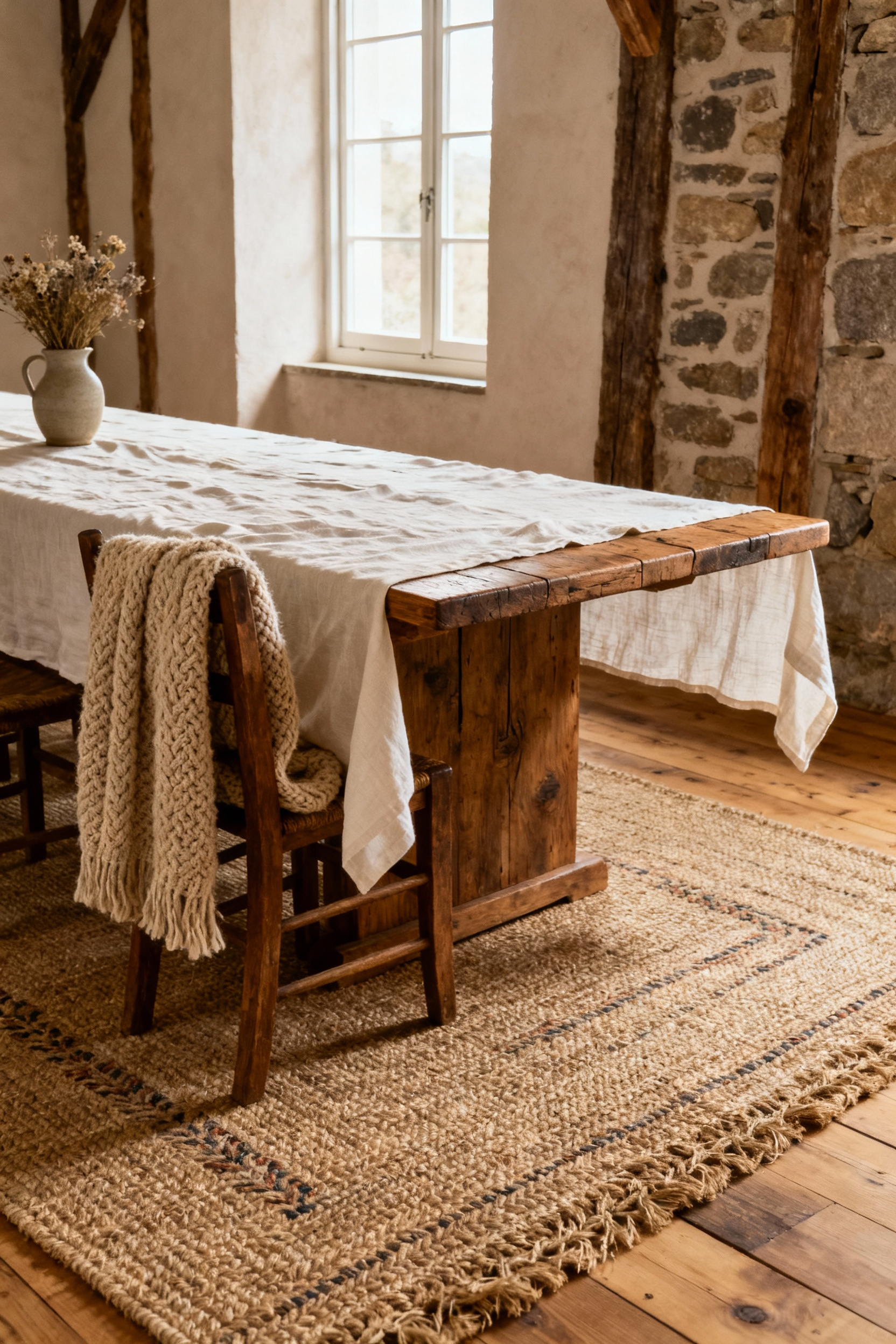
The material selection is strict: fibers that come from nature. Linen brings a crisp yet relaxed drape to curtains or a tablecloth. Wool, celebrated for its coziness and durability, is perfect for a substantial area rug that will absorb sound and add immense tactile warmth. Jute, with its rugged, earthy texture, offers a grounding element. The strategic deployment of these textiles is key. A substantial wool or jute rug under the dining table defines the gathering zone and transforms echoes into comfortable murmurs, making the room instantly more inviting.
10. Employing Artisanal Metalwork: Forged Iron
The integration of forged iron is a detail many overlook, but in my experience, it’s a profound anchor for an authentic rustic space. Unlike mass-produced hardware, hand-forged elements carry a human story; each hammer strike is visible. This isn’t just a decorative choice, but a commitment to an aesthetic that values permanence and tangible craftsmanship. Its raw, honest materiality resonates deeply with the rustic ethos, contrasting beautifully with the organic warmth of timber.

Think about the tactile experience: the satisfying heft of a forged iron door latch, the robust look of cabinet pulls, or the sturdy strap hinges on a cupboard. Lighting fixtures are a pivotal opportunity here. A substantial wrought iron chandelier over the table becomes the room’s gravitational center, its dark linearity a compelling counterpoint to softer textures. These pieces are not mere accessories; they are sculptural accents that lend an unpretentious sophistication and an unwavering sense of authenticity to the rustic dining room.
Orchestrating Spatial Dynamics: Arrangement and Illumination
With our philosophical and material foundations in place, we can now turn to the art of arrangement. The orchestration of space and the nuanced play of light are what elevate a collection of fine objects into an environment that truly works.
11. Defining Zones with Farmhouse-Style Benches and Chairs
A well-conceived dining room is not just about the table, but how you arrange life around it. The classic farmhouse bench, for example, is more than just seating; it’s an architectural tool for defining space. Philosophically, it speaks of communal unity—its form an inherent invitation to gather. A bench along one side of a table immediately demarcates the primary dining zone, distinguishing it from surrounding pathways or a fireside seating area.

In my professional experience, the most successful layouts feel both expansive and intimate. Using a robust bench against a wall can create a banquette, fostering intimacy and making efficient use of space, especially when paired with chairs on the opposing side for easy access. The arrangement should always prioritize conversational dynamics, ensuring movement is unencumbered and eye contact is natural. It’s about designing a space that adapts to life, rather than one that dictates it.
12. Optimizing Natural Light with Unadorned Windows
Natural light is not merely illumination; it’s a living, dynamic element that connects the interior to the world outside. The guiding principle here is a reverence for that connection. This means preferring unadorned or simple casement windows that allow an uninterrupted flow of daylight. Any design choice that obstructs that light or the view is a missed opportunity.

The absence of heavy drapery is a deliberate decision, not an oversight. It signals a belief that the view itself—whether of a rugged landscape or a simple garden—is the primary art. If privacy is needed, a lightweight, natural linen sheer is enough. A dining table placed to catch the morning sun can animate the textures within the room—the grain of the wood, the weave of a rug—creating a play of light and shadow that breathes life into the space all day long.
13. Implementing Layered Illumination
As natural light fades, a sophisticated approach to artificial light is essential. I always recommend layered lighting—a carefully considered tapestry of ambient, task, and accent light. A dining space serves many functions, from bright, busy homework sessions to intimate dinners, and the lighting must be able to adapt. The monumental fixture is, of course, the statement chandelier over the table, providing ambient light. I’ve noticed people often hang them too high; they should relate to the table, not the ceiling, creating a more intimate canopy of light.

This central light must be augmented with other sources. Wall sconces can illuminate a sideboard or art, providing softer, localized pools of light. Dimmers are not a luxury; they are an absolute necessity for every light source in the room. They give you granular control over the mood, allowing the space to transform at the touch of a button. And pay attention to the bulb’s temperature—a warm light (around 2700K) is crucial for enhancing the cozy, inviting atmosphere of a rustic dining room.
14. Employing Bespoke Built-Ins and Nooks
To achieve true functional and aesthetic integrity, storage and display should feel inherent to the structure, not like afterthoughts. Bespoke built-ins and artfully crafted nooks elevate storage from mere containment to architectural expression. They eliminate visual clutter while celebrating the objects that enrich daily life. I’ve found this is a key part of making an older home work for modern life while preserving its character.
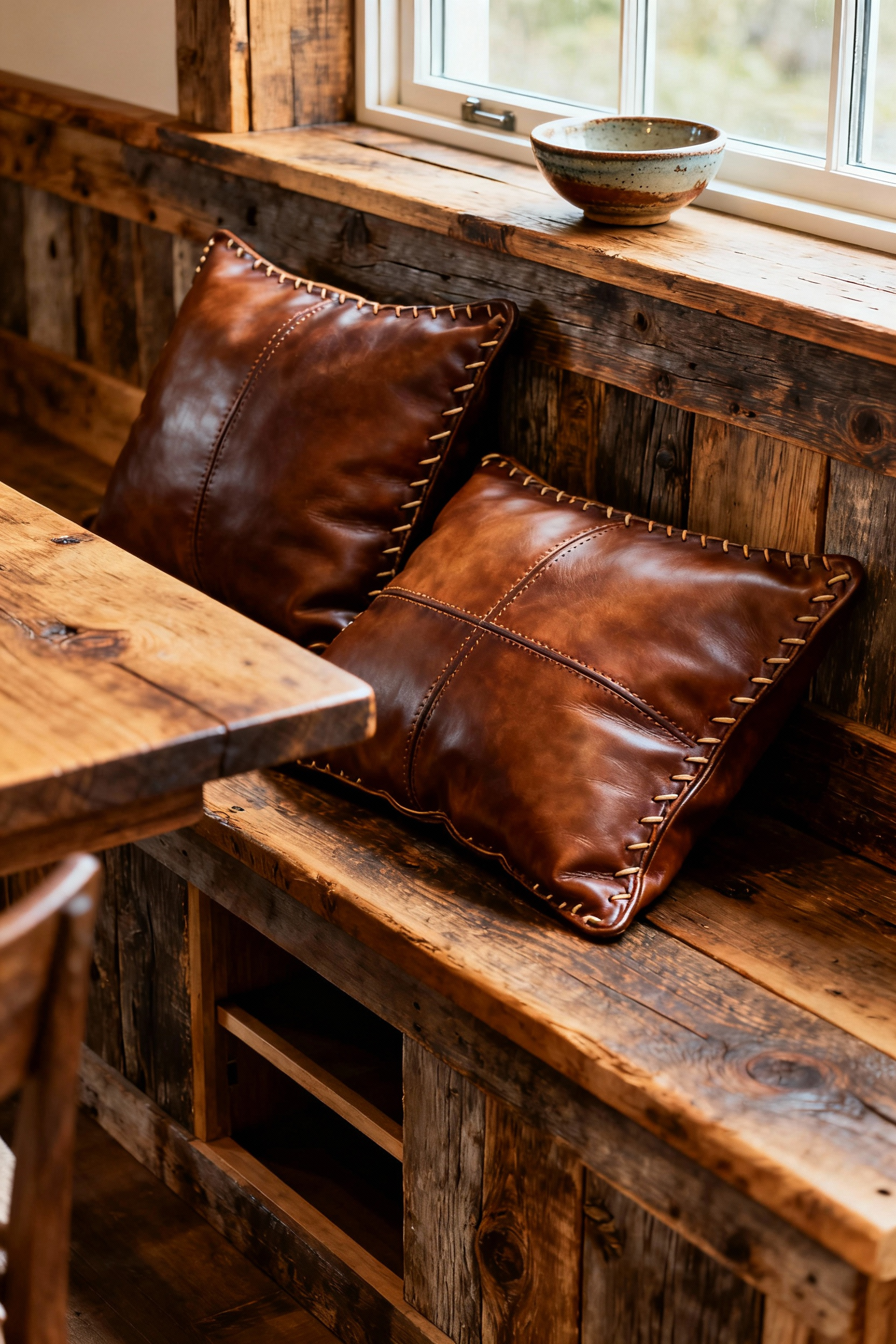
A built-in hutch flanking a window can frame the view while providing storage for serving ware and open shelving for heirlooms. A window seat with a hinged top offers both seating and discreet storage for linens. These elements, crafted from materials that match the room’s ethos—reclaimed barn wood, rough-sawn oak—create a sense of permanence and order, allowing the beauty of the primary elements to truly shine.
15. Ensuring Proportional Grandeur with an Oversized Table
The dining table is the philosophical and physical nucleus of the room. It must command the space. “Oversized” here isn’t about excess; it’s about deliberate proportional grandeur. A table that feels substantial and immovable inherently conveys stability and permanence—hallmarks of the authentic rustic aesthetic. It’s a powerful statement against our disposable culture.

Spatially, the oversized table dictates the flow of the entire room. It must have room to breathe; cramming it in defeats the purpose. Ample clearance around the perimeter isn’t just for circulation; it’s to frame the table’s gravitas. I learned this when a client fell in love with a massive 12-foot table for a room that could just barely fit it. We had to simplify everything else—slimmer chairs, minimal other furniture—to allow the table to be the hero. And it worked beautifully. It became an anchor for daily life, inviting everything from sprawling projects to impromptu gatherings.
Cultivating Enduring Ambiance: Lifestyle and Artisanal Narratives
Beyond the physical, a truly rustic dining room embodies a way of living. It’s in the final layers—the objects we touch, the way we gather, and the connection to nature—that the space comes alive and finds its enduring warmth.
16. Curating Eclectic Tableware: Pottery, Stoneware, and Glass
The soul of a dining room is expressed most intimately through the objects we use every day. The tableware should be an extension of the handcrafted ethos. I advise clients to move away from perfectly matched sets and instead curate a collection of pieces with character—hand-thrown pottery, resilient stoneware, and artisanal glass, each telling the story of its creation.

It’s about harmonizing, not matching. A collection of deeply textured terracotta bowls alongside smooth stoneware plates creates visual depth and interest. It transforms the act of setting the table into an exercise in thoughtful composition. This fosters an environment where every meal, no matter how simple, feels like a ritual elevated by the unique character of its vessels.
17. Incorporating Heirloom Pieces and Found Objects
A rustic dining room should feel like a living archive of memory and meaning. Integrating heirloom pieces and found objects imbues a space with a soul that you simply cannot purchase new. Sterile, unburdened interiors lack the resonant hum of accumulated experience. An heirloom farm table wears its scratches like a map of countless shared meals. Even objects discovered at an antique market—a tarnished silver serving spoon, a stack of worn linen napkins—carry a visual weight that new items lack.
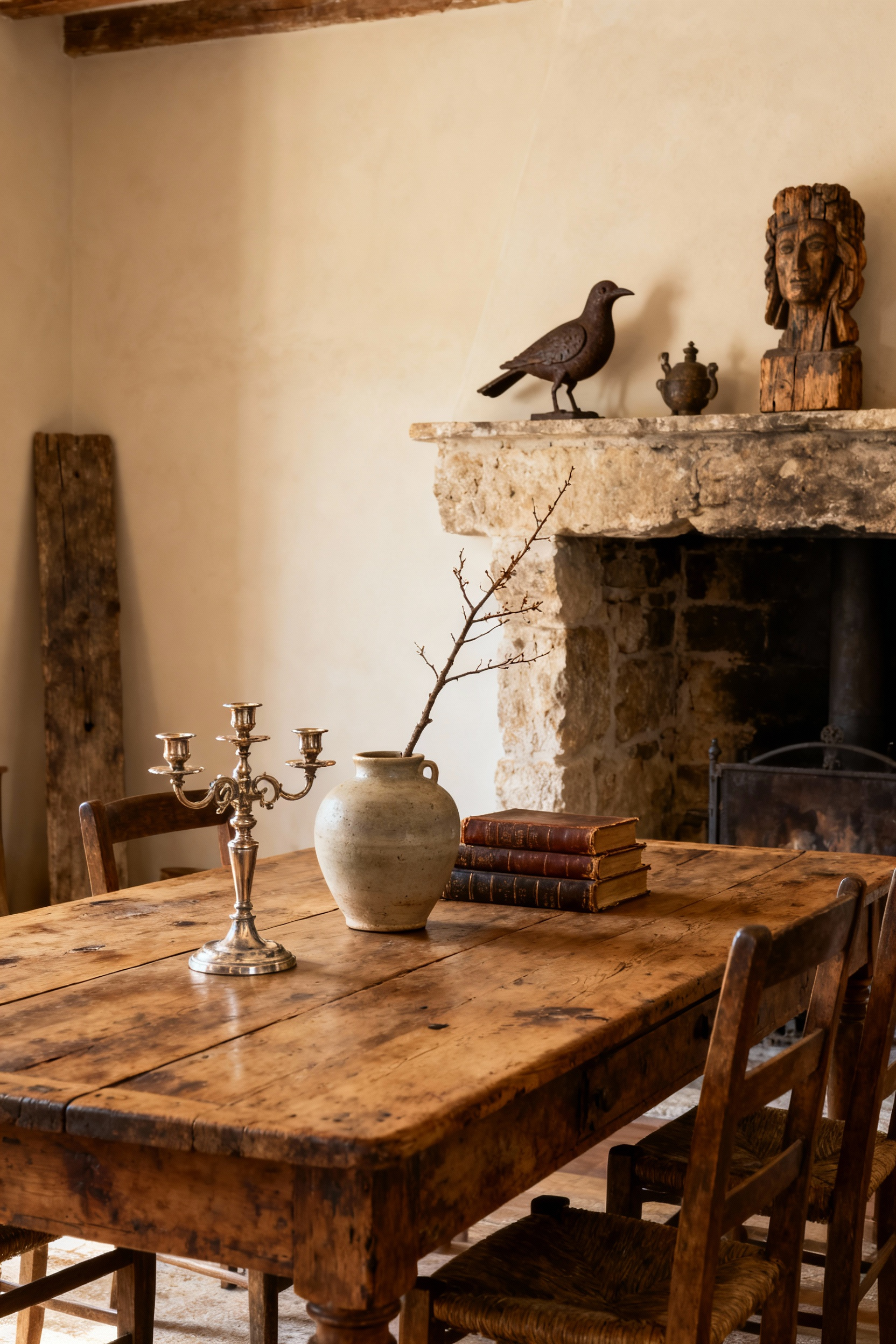
I always encourage people to display these items. A collection of inherited platters on open shelving adds a tangible connection to family heritage. It’s about shifting the paradigm from consumption to stewardship. By weaving heirlooms and found objects into the room’s fabric, you cultivate a space that is not only visually compelling but deeply personal, inviting reflection and fostering a unique sense of belonging.
18. Designing for Unpretentious Gatherings
The true measure of a successful dining room is not its beauty, but its ability to foster genuine human connection. The design must serve that ultimate purpose. The goal is an atmosphere where laughter feels effortless and conversation flows freely, where guests feel they can put their elbows on the table.
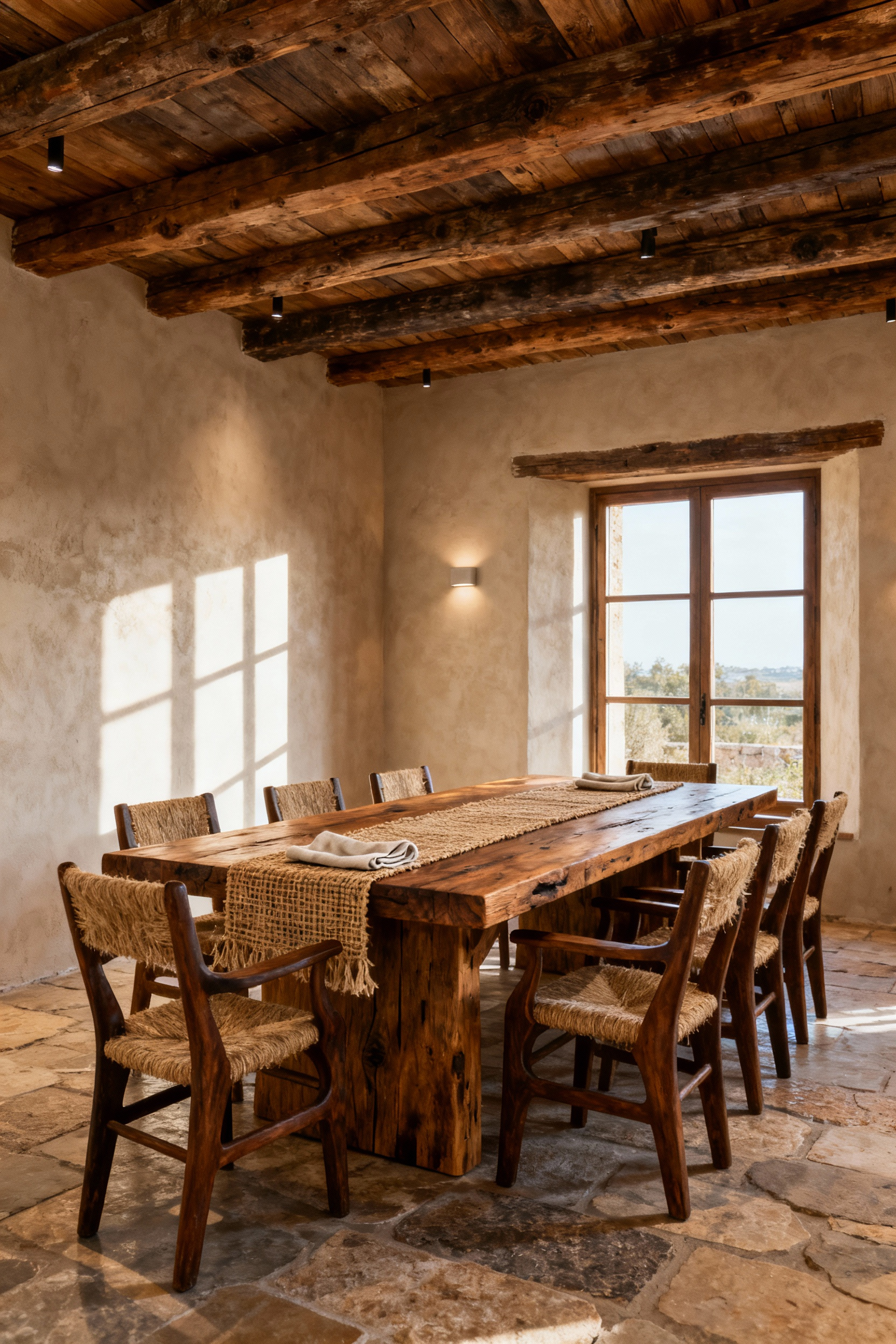
This means prioritizing comfort. Seating must encourage lingering. Tabletops should be durable and unpretentious, welcoming spills without stress. The lighting, as we discussed, should be warm and gentle. This philosophy promotes a culture of relaxed entertaining, where the space is continuously in use. A rustic dining room designed this way becomes the heart of an authentic home, a sanctuary where connection is not just possible, but inevitable.
19. Harmonizing with Natural Botanicals and Dried Elements
The final layer of ambiance involves creating a seamless dialogue between the interior and the natural world. Bringing botanicals into the room isn’t mere decoration; it’s about infusing the space with organic vitality, reflecting the rhythm of the seasons. It’s a way of grounding the home in its landscape.
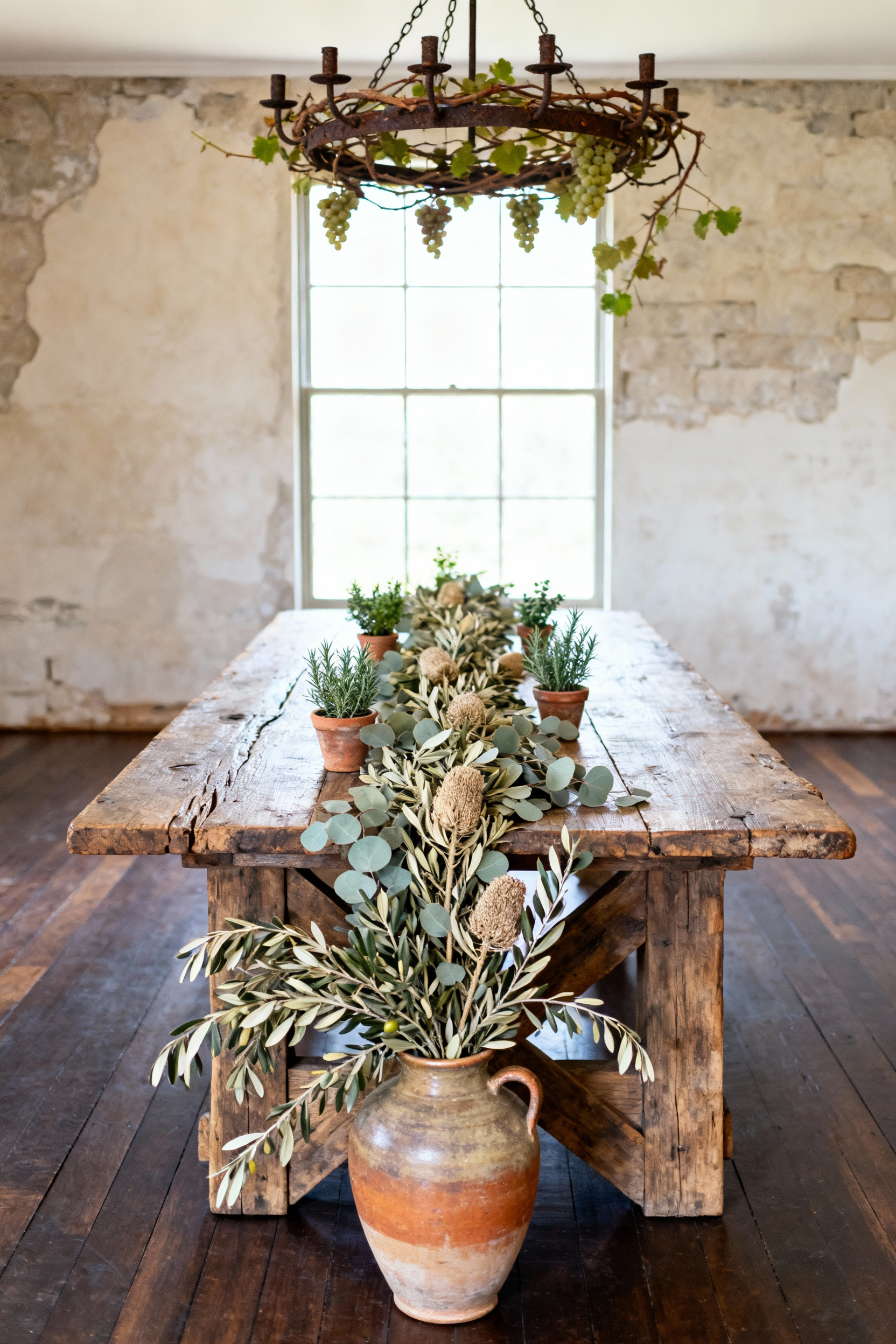
A simple branch heavy with autumn leaves, a handful of wild grasses in a clay pot, or the enduring forms of dried seed pods can soften architectural lines and add warmth. A sprawling, low centerpiece of foraged branches on the table can become a focal point without impeding conversation. By integrating these natural elements, you create a space that feels deeply rooted, connected, and continuously refreshed, making every meal a tribute to both craftsmanship and nature.
20. Investing in Durability and Timeless Design
In an era driven by the next new thing, choosing timelessness is an act of deliberate resistance. True longevity in a rustic dining room comes from an unwavering commitment to enduring quality. This is the cornerstone of my professional philosophy: to be a steward of a home, advocating for pieces that age with grace and become cherished heirlooms.
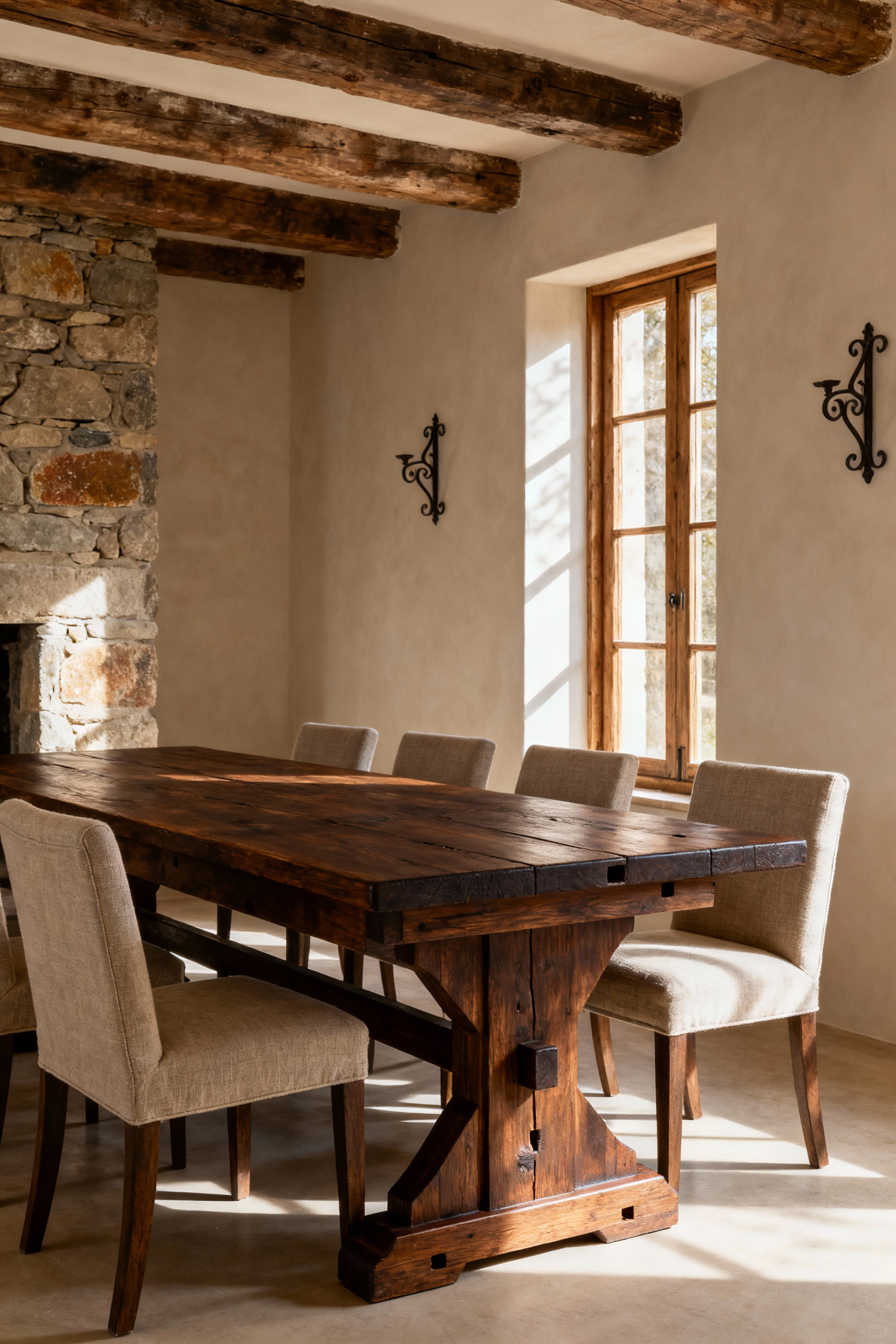
This manifests in the meticulous selection of materials and craftsmanship. It’s the solid oak table, the hand-forged chandelier, the chairs built with traditional joinery. These are not expenses; they are investments in the physical and emotional resilience of a space. A room built on these principles becomes a sanctuary for shared life, a testament to thoughtful living where the beauty is not in newness, but in authenticity, resilience, and the quiet dignity of things made well.
Conclusion
Having explored these guiding principles, it’s clear that creating a rustic dining room is not a matter of following a formula. It is, at its core, an act of honoring an old way of life where utility and beauty were one and the same. True rustic appeal is found in a profound respect for craftsmanship, the honesty of natural materials, and the integrity of a design that serves human connection first. It is in the sturdy grain of salvaged wood, the warm glow of hand-forged iron, and the comfortable chair that invites you to stay a while.
These principles form a cohesive philosophy that champions heritage and mindful living over fleeting trends. I encourage you to approach your own dining room not as a design project, but as an act of curation. Allow these insights to inform your choices, fostering a space that resonates with history and natural beauty, but also deeply reflects your reverence for enduring quality. In doing so, you will not merely design a room, but cultivate an environment where the timeless spirit of gathering can truly flourish—a lasting testament to a life lived with intention.
